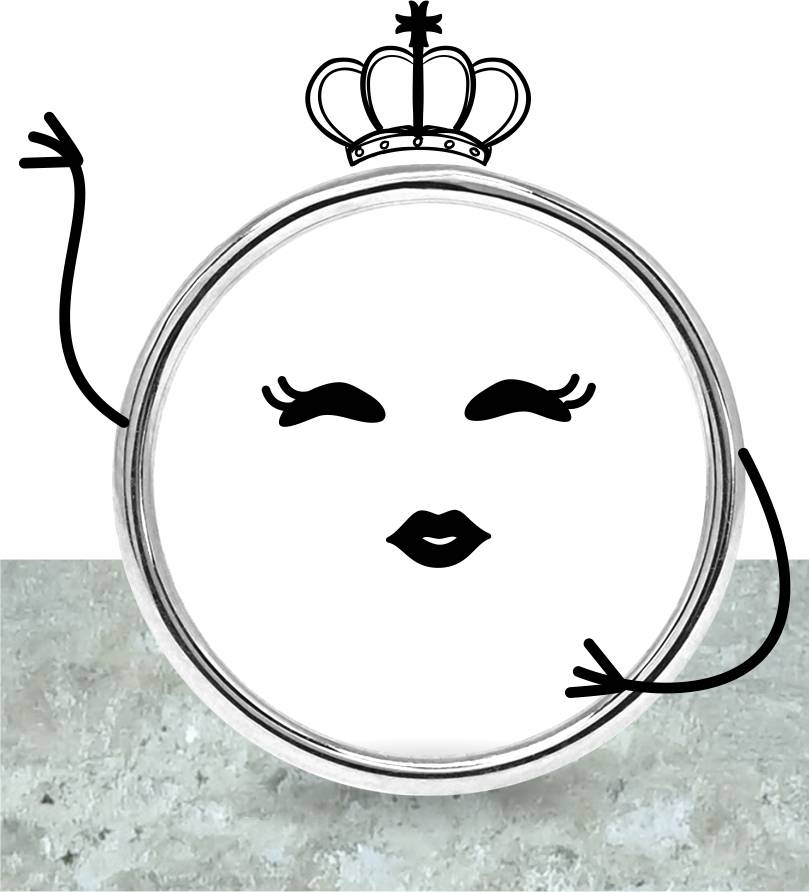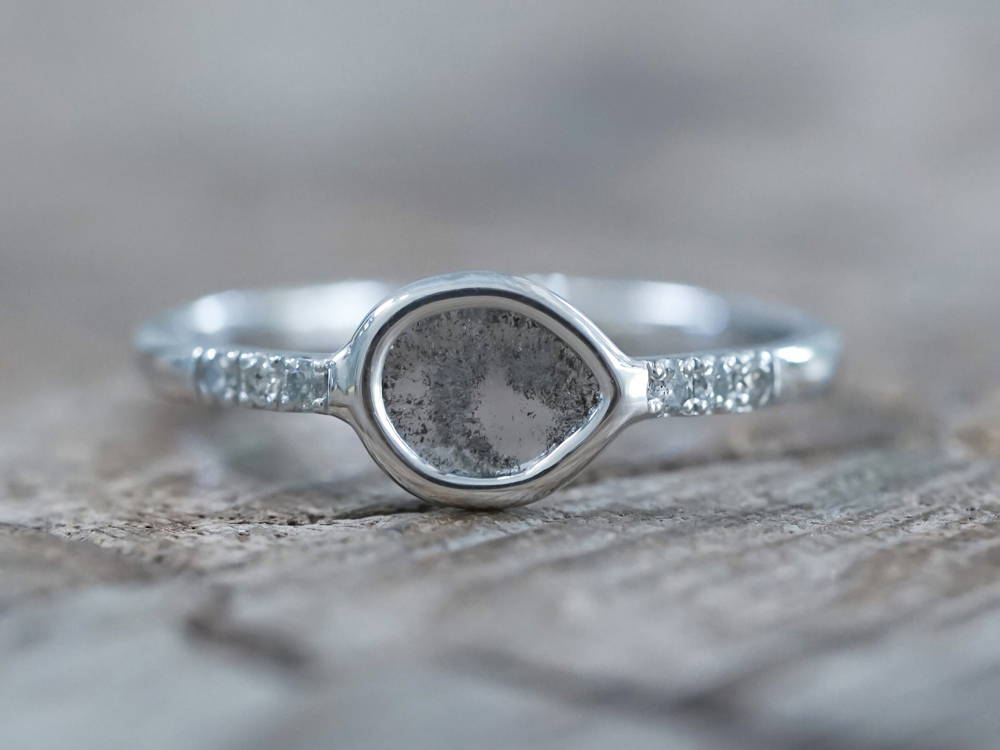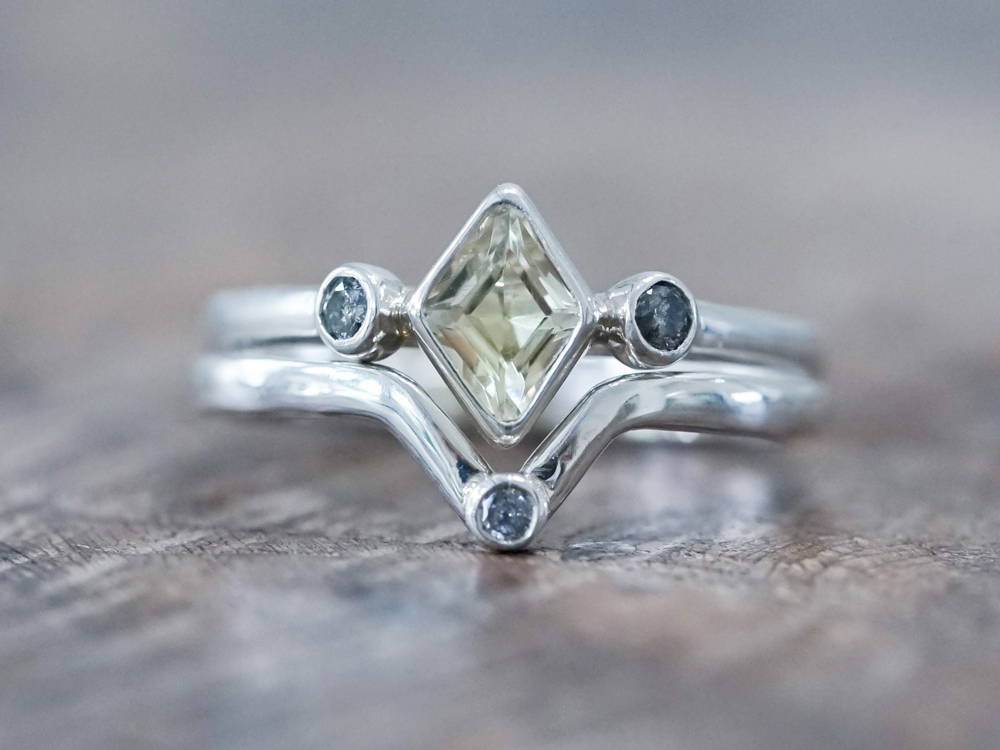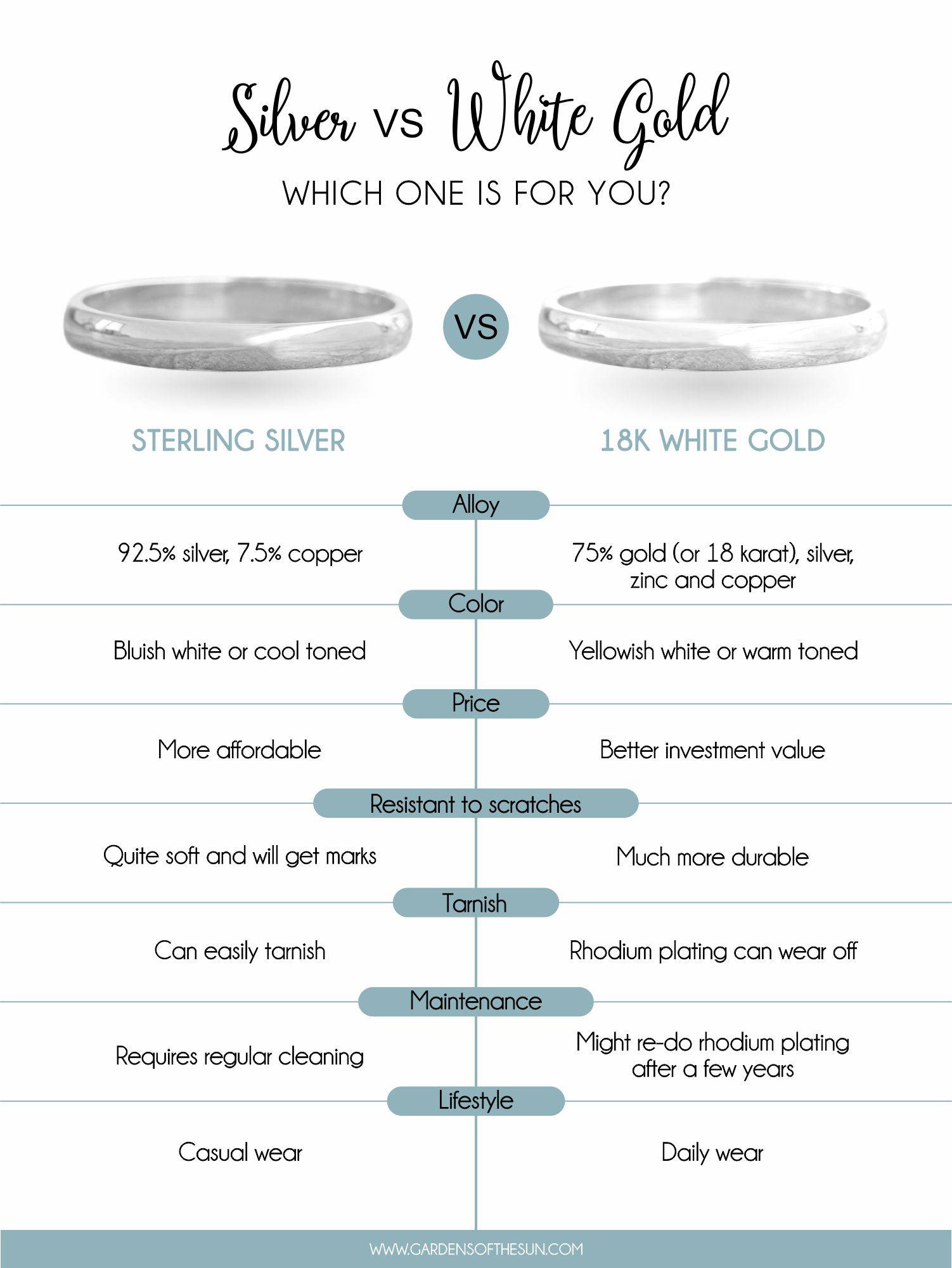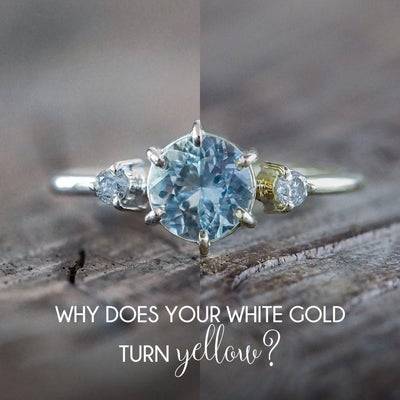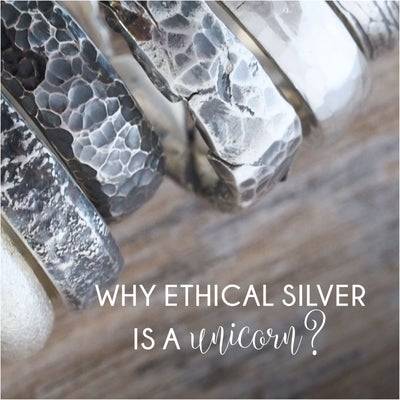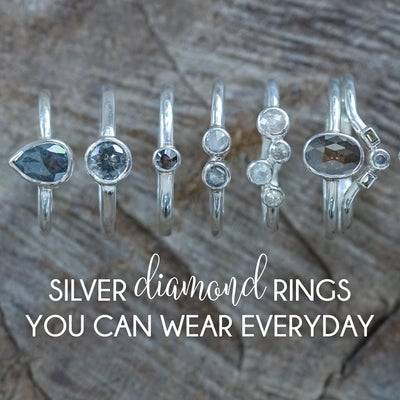Your Cart is Empty
Silver vs White Gold: which metal should you choose?
For brides-to-be eyeing the white metal wedding band look, you might be wondering: should I choose for a silver or a white gold ring band?
Silver may be the go-to ring for budget reasons (it can be many times cheaper than white gold!). But silver vs white gold - this question doesn’t just beg budget talk. The ultimate question of how long you want to wear your ring, how you want the ring to look and what kind of wear and tear you expect. Because even though both boast a white metal look, they’re different when it comes to wearing them day to day.
With both options readily available, how do you know if you’re a silver or a white gold gal?
What’s white gold?
White gold is a gold alloy made from gold with a mix of zinc, silver, nickel, palladium and/or copper (the exact mix tends to vary for different jewelers).
Pure gold has a very rich and intense yellow color, so a mix of metals are needed to alter its finished look - make it less yellow and more pale.
Other metals in white gold give it durability and color.
Gold on its own can’t be made into jewelry, because it’s a very soft metal (bite it and it’ll have teeth marks!).
What’s STERLING silver?
Silver is a metal which is found alongside other metals and has a natural white metal look.
Similar to gold, silver is a soft and brittle metal.
It doesn't need the addition of other metals to adjust the color. Pure silver does, however, need to be alloyed with other metals for strength and durability.
Sterling silver is 92.5% silver and 7.5% other metals, usually copper. Fine silver contains a higher silver content than sterling silver, as high as 99%. More on alloys below.
Alloy
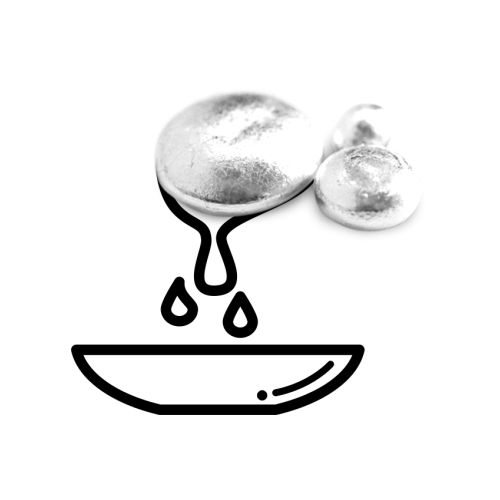
White Gold
We use silver and zinc in our white gold alloy. Zinc is naturally rust resistant, a strong metal, has a bluish-white color, and very stable. It’s the perfect metal to be combined with white gold. Since gold has a very deep yellow hue, adding up to a quarter of zinc and silver just isn’t enough to transform the color. Your ring will have a yellow undertone and has to be rhodium plated. Gold with a lower gold content (like 9K, which contains 37.5% gold) tends to be whiter in color, since it has a higher content of other metals.
Sterling silver
Most silver jewelry is sterling silver, which is the pretty name for silver alloy. By default, anything with 92.5% silver content is called sterling silver. If you see the number 925 on your silver piece, then it’s sterling silver. The other 7.5% is usually copper, but it may also contain zinc or nickel.
A dash of copper in the mix adds a substantial amount of durability to the ring, even though copper develops a thin layer of green patina over time (think Statue of Liberty, which was made out of copper and is now a green sculpture). Zinc adds durability too, and nickel adds sparkle. We don't use any nickel in our sterling silver.
Don’t confuse sterling silver with fine silver! Fine silver has a 99% silver content, which makes it a lot softer, but less likely to tarnish. We use fine silver for some parts of our Hidden Gems collection so that the metal can grip the tiny pieces of rough gemstones.
Color
A white gold ring with a salt and pepper diamond slice
White gold
White gold can be very shiny and bright, matching the shine of platinum. But this shine actually doesn’t come from the gold or the alloy, but from the rhodium plating.
Rhodium plating gives the ring that beautiful reflective shine and resistance to scratches. Without rhodium plating, white gold will have a yellow undertone (which some people love).
A sterling silver stack ring with kite cut beryl and salt and pepper diamonds
STERLING Silver
Silver is shiny and lustrous, with a slight hint of grey. It’s not as bright as rhodium plated white gold.
Silver is easily textured and stylized with various oxidation methods. Over time, silver may develop a patina.
Price
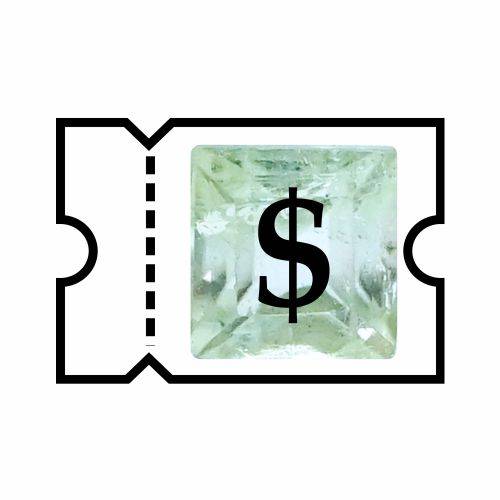
White gold
White gold is pricey, but less expensive than platinum (another precious metal even more valuable than gold, often used as a collector’s choice in jewelry). Your jeweler may charge more for white gold than yellow or rose gold, because of the rhodium plating or the addition of palladium in the alloy, which is more expensive than gold.
sterling Silver
Silver is a cheaper alternative to gold. Because silver is more abundant than gold, it has a lower financial value.
FUN FACT
There’s a thing called gold : silver ratio to set the price of these metals. For centuries, the gold : silver ratio was 16 : 1, meaning that if a chunk of silver costs $100, a gold chunk of the same weight will sell for $1,600. Nowadays the ratio has increased to 60 : 1.
Is silver or gold a better investment for fine jewelry?
When it comes to investing in fine jewelry, its value goes way beyond the metal. The gemstone and the design of the jewelry can raise the value. The rarer the gemstones, like a natural saltwater pearl or a natural blue diamond, the higher the value. Likewise, vintage pieces may command a higher price simply because it's a historical piece. Investing in fine jewelry is just like investing in art.
But when it comes to silver versus white gold, white gold takes home the medal. For jewelry, gold matches the value of high value stones. It’s also more durable than silver and can maintain the setting’s shape and shine for a much longer time. So for those treasured gemstones and heritage diamonds, gold is a better investment that will outlast silver.
Scratch resistance
White Gold
White gold is stronger and more durable than silver. The combination of metals give white gold its color and durability. Without it, pure gold is just as soft as pure silver. Additionally, white gold may be rhodium plated, which gives it a shiny top layer.
sterling Silver
Silver on its own is malleable and soft. Even as sterling silver, silver scratches quicker than white gold. Over time, you’ll see silver rings having natural marks from daily wear.

Does it tarnish?
(aka gets darker or changes color over time)
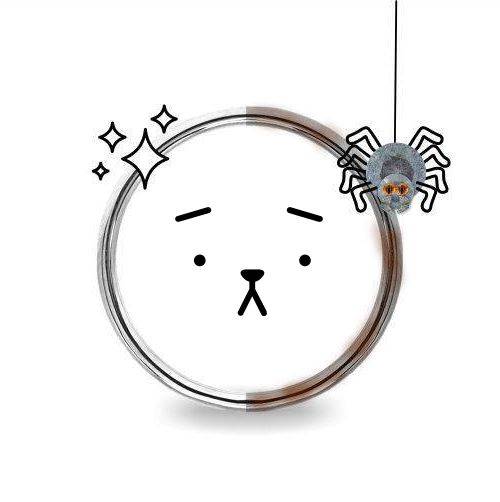
White Gold
Similar to silver, gold on its own doesn’t tarnish. There’s little to no chemical reaction happening between pure gold and the environment, but other metals in the alloy react to the environment. That’s why, the lower the karat and the higher the alloy content, the faster it can tarnish.
sterling Silver
Silver on its own doesn’t tarnish, but the other metals in the alloy might. You’ll see how silver jewelry develops patina (a dark grey to black film formed on the surface) as it reacts to the environment. In this case it’s actually metals like copper which are susceptible to tarnishing.
Unlike rusting, which can ‘eat up’ the physical form and is irreversible, tarnishing doesn’t physically damage the silver. Silver tarnishes quicker than gold.
Maintenance
White Gold
White gold alloy is well protected by rhodium plating, even though rhodium plating itself won’t last forever. After a few years, the rhodium plating will fade and need reapplication. When you see yellow tinge peeking through, you’ll know it’s time to re-do that rhodium plating!
If your white gold is palladium based, the color will be more that of a white metal and you might not need rhodium plating. This means it's much lower maintenance than a rhodium plated white gold ring. So if you're planning on getting a white gold ring, always ask the jeweler whether it's rhodium plated or not!
sterling Silver
Silver alloy tends to tarnish rather quickly, so it needs regular cleaning and polishing
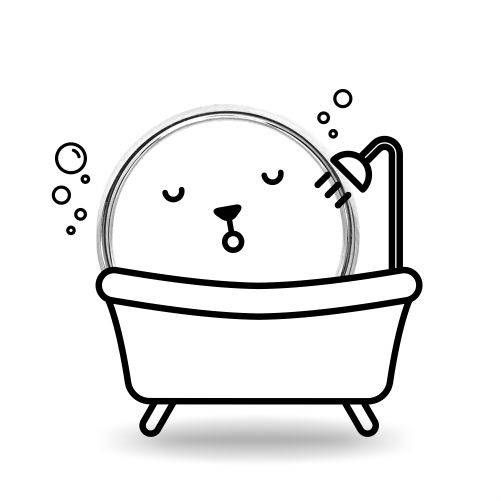
Lifestyle
White Gold
White gold rings are great on their own as a wedding band or together with your dream gemstone. Rhodium plating will avoid your ring looking dull, especially against the sparkle of your gemstone. It will also protect the gold underneath, like a protective layer. But then again, if you want something low maintenance, we suggest you opt for a platinum engagement ring or a palladium based white gold, since rhodium plating will wear off over time.
sterling Silver
Silver rings can be much more affordable than white gold rings - partly because of the quality of the gemstones or diamonds used in it. But the ability of silver to withstand daily wear is subpar compared to white gold. If you wear your silver jewelry every single day, blotches and tarnishes will become visible with time, and after decades of wear your silver might break.
That being said - a worn out silver ring can have a lot of charm. Like an old, yellowing book, some marks of time in your silver ring show signs of being well loved.
Silver jewelry needs some TLC and regular cleaning. If you don’t mind polishing it every now and then, or like the idea of a roughed-up look over the years, silver can be your metal of choice.
Still feeling doubtful about which metal to choose?
Send our Customer Happiness Rockstars an email, and ask away any questions you have!








